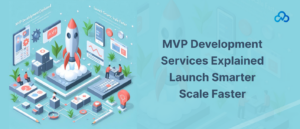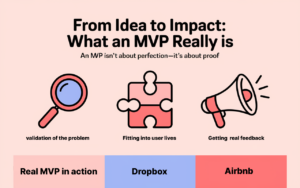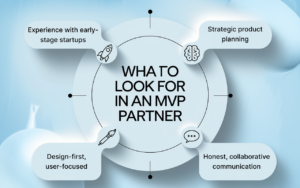MVP Development Services Explained: Launch Smarter, Scale Faster

When you’re building a startup, the goal isn’t to wow people with fancy features right out of the gate. Instead, it’s to solve a problem that matters, with a product that actually works. Sounds simple, right? But it’s surprisingly easy to miss, especially when you’re chasing perfection instead of progress. Sure, founders usually have big ideas. That’s not the issue. The real challenge lies in knowing how to turn those ideas into something people will actually use. And even more importantly, figuring out if they even want what you’re building, before you sink months (or even years) into it. That’s exactly where minimum viable product software development comes in.
A Minimum Viable Product isn’t just a trendy buzzword or some item to check off a startup to-do list. Think of it more like a filter. It sharpens your focus and forces you to zero in on what’s essential. In other words, you build just enough to test your assumptions, gather real-world feedback, and find out if your idea can stand on its own.
And if it doesn’t? Even better. You’ve saved yourself time, money, and a whole lot of future headaches.
In this article, we’ll break down how minimum viable product software development actually works in the wild. You’ll get a clear picture of why smart startups lean on it, what you should expect from a solid MVP agency, and how this lean approach helps you build momentum, without burning through your entire budget before launch.
What an MVP Really Is
So, what is MVP, really? Think of it as your product stripped to its essentials. No fluff, no fancy extras. Just the core idea, built in a way that actually works for someone. Not everyone, just someone. The goal isn’t perfection. The goal is proof.

A lot of people hear “minimum” and assume low quality. That’s a mistake. A welldone minimum viable product software development can be incredibly effective. It doesn’t have to be flashy, but it should be clear, usable, and good enough to solve a specific problem. And when done right, it’s powerful.
Here’s what a proper MVP does:
- Tests whether the problem you’re solving really exists for users.
- Shows if your solution fits into their life, their habits, or their workflow.
- Gets you real feedback. The kind that changes roadmaps, not just confirms guesses.
Still with me? Good. Let’s take a look at two quick examples.
Dropbox didn’t build out the full platform right away. Instead, they created a simple explainer video showing how it would work. That one video was enough to validate demand before writing all the code.
Airbnb started with nothing more than a couple of air mattresses in an apartment and a basic booking page. People booked. That was the signal they needed to go further.
What does this tell us? Minimum viable product software development isn’t about cutting corners. They’re about clarity. You’re not building everything at once, you’re building just enough to learn something real.
Why More Startups Are Betting on MVP Development Services
Launching a tech startup in 2024 is no walk in the park. Sure, the tools are better than ever, but the competition is brutal. Everywhere you look, niches feel saturated, funding is hard to come by, and expectations are sky-high from day one.
Now, to be clear, it’s not that founders aren’t putting in the work. They are. However, the real issue is that too many are working hard on the wrong things.
This is exactly where an MVP development agency comes in.
Rather than stumbling through product development blindly, minimum viable product software development helps you test the waters before you dive in. With the right team in place, you can launch something functional, gather real-world insights, and adapt quickly—all before your budget goes up in flames.
Validate Without the Guesswork
Guessing what your users want? That’s a gamble. Sure, you can talk to people, browse forums, or run surveys. But at the end of the day, until your product is actually in their hands, you’re still working off assumptions.
That’s why an MVP development agency is such a game-changer. They allow you to:
-
Test your product idea with real users
-
Spot friction points early in the journey
-
Avoid bloated features that nobody asked for
To be clear, this isn’t about rushing a half-baked launch. Instead, it’s about learning fast and iterating smart. You pay attention to what users do, not just what they say. Whether they click, convert, or disappear entirely, it’s all valuable data you can act on.
Launch Fast, Learn Faster
In the startup world, timing can make or break you. Miss your window, and someone else will move faster.
That’s why MVP services are designed for speed, without sacrificing quality. With them, you get:
- Short, focused sprints using agile methodologies
- Tight feedback loops to shape your roadmap
- Built-in testing baked into the process
The real win here? You don’t just launch quickly, you launch wisely. Because by the time your product hits the market, it’s already backed by data, feedback, and real usage.
Spend Smarter, Not More
Money’s tight early on, always. Whether you’re bootstrapped or managing a modest pre-seed, every peso or dollar counts.
That’s why MVP development helps you avoid costly mistakes. Instead of building a full-featured product nobody ends up using, you can:
-
Focus only on the features that move the needle
-
Reduce development hours by trimming the fat
-
Invest in insight, not shiny distractions
Ultimately, this isn’t just lean startup theory, it’s practical survival. You build less. You learn more. And most importantly, you save your runway for the moments that really matter.
Inside the Minimum Viable Product Software Development Toolbox: What These Services Actually Include
Minimum viable product software development services aren’t just about slapping together a barebones prototype. On the contrary, there’s a well-thought-out structure behind it, a process that’s both strategic and iterative, balancing speed, quality, and insight. Whether you’re partnering with an agency or building with your own team, you’ll find that the typical MVP journey follows a clear and proven path.
Discovery and Strategy
To begin with, nothing gets built until your team understands exactly what you’re trying to achieve. In many ways, this first phase lays the foundation for everything that follows. This is the point where your minimum viable product software development team takes a deep dive into your goals, your users, and the core problem you’re setting out to solve.
During this stage, you’ll typically go through:
-
Foundational conversations to clarify your vision
-
Market research to assess competitors and, just as importantly, uncover their gaps
-
Persona development and user journey mapping to align design with behavior
-
Feature prioritization using structured methods like MoSCoW or RICE scoring
As a result, by the end of this step, you’ll walk away with solid documentation, think requirement briefs, lean canvases, and sometimes even rough wireframes. In short, it’s about creating shared clarity before a single line of code is written.
User-Centered Design
Next up, we move to design. But don’t be fooled, this isn’t just about aesthetics. In fact, when it comes to MVPs, design must be functional, intuitive, and laser-focused on usability. Even though you’re only launching with a few core screens, those screens need to deliver.
At this stage, you’ll likely focus on:
-
Wireframing and flow diagrams to ensure users don’t get lost
-
Building interactive prototypes that simulate real functionality
-
Testing those prototypes early to spot confusion or friction
Consequently, if your users can’t figure things out within the first minute or two, you risk losing them. That’s why a smart, user-first design process is essential, it keeps users engaged, confident, and coming back.
Lean MVP Development
Once the design holds up under scrutiny and testing, it’s finally time to build. However, you’re not building everything, just what truly matters.
Generally speaking, this includes:
-
Flexible back-end frameworks like Django or Node.js
-
Front-end stacks like React or Vue for speed and responsiveness
-
Lightweight, modular architecture (think microservices)
-
CI/CD pipelines to ensure fast, stable deployments
At the core of it all, the goal is to stay agile. Your MVP needs to be strong enough to handle real user feedback, yet, lightweight enough that pivoting doesn’t require tearing everything down. In other words, you’re building for change.
Test, Deploy, and Repeat
Contrary to popular belief, testing isn’t something that happens at the very end, it’s integrated into every step of the process.
Here’s how testing typically plays out:
-
Manual QA combined with automated unit and integration testing
-
Real-time bug tracking through tools like Sentry, Jira, or GitHub
-
Soft launches to early access users or private beta groups
-
Performance monitoring to catch crashes, slowdowns, or unexpected behavior
As feedback starts flowing in, it gets funneled directly into your sprint backlog. Then, it’s incorporated into the next build. This cycle, test, deploy, improve, repeats constantly, creating a feedback loop that helps your product get sharper, faster, and more aligned with user needs.
Over time, what you end up with isn’t just a working MVP, it’s a version of your product that’s been pressure-tested in the real world, and more importantly, shaped by the people who will actually use it.
Finding Your Tech Co-Founder (Without Giving Up Equity)
You don’t need to hand over a piece of your company just to get your first product built. Seriously. A solid MVP development partner can do what a technical co-founder might—without asking for equity or a long-term commitment.
In many cases, the right agency plays the role of a temporary CTO. They help shape the product, bring clarity to the roadmap, and guide the build with both strategy and execution. And when the MVP is done, you keep your cap table clean.
What to Look for in an MVP Partner
Not all agencies are the same. Some just code what you tell them. Others think with you, push back when needed, and help you avoid mistakes before they happen.

Here’s what the good ones usually offer:
-
Experience with early-stage startups and product launches
-
Strategy sessions that go beyond surface-level planning
-
A design-first mindset focused on user experience
-
Honest conversations, especially when something’s not working
Red Flags That Should Raise Eyebrows
If you notice any of the following, be cautious:
-
No clear roadmap or onboarding process
-
Vague about timelines, deliverables, or pricing
-
Pre-packaged solutions that feel one-size-fits-all
Green Flags That Show You’re in Good Hands
On the flip side, here’s what trustworthy MVP agencies often bring to the table:
-
Real case studies showing traction and results
-
Transparent planning, including milestones you help define
-
Tools for collaboration like Slack, Notion, or shared docs to keep everyone aligned
Quick MVP Partner Checklist
Use this to vet your options:
-
Transparent, upfront pricing
-
Consistent progress updates
-
Tech stack that fits your needs, not just theirs
-
Strategic input during both planning and development
A good MVP agency doesn’t just build what you ask. They help build what you need, even if that means challenging your assumptions along the way.
Scaling Beyond the MVP: What Comes Next?
Launching an MVP is just the start. Now that you’ve validated the core idea, the real work begins, turning that early spark into something scalable and sustainable. However, scaling isn’t about piling on features just because you can. Instead, it’s about making smart, data-driven decisions that strengthen both your product and your company over time.
Sharpening Your Product Through Iteration
Your MVP helped you learn what works, and probably what doesn’t. Therefore, now’s the time to apply those lessons with intention. To guide your next steps, consider the following:
-
Track user behavior using tools like Hotjar or Mixpanel
-
Run interviews or quick surveys to hear what users actually think
-
Prioritize new features based on real value, not just popularity
-
Stay focused: after all, every new feature should support your core mission
Ultimately, iteration isn’t about making your product bloated, it’s about refining it until it truly solves the problem better than anything else.
Creating a Living Roadmap
Next, as your product grows, so should your roadmap. But remember, a roadmap isn’t static, it’s a living document that needs to evolve alongside your users.
Here’s how to keep it relevant:
-
Set up easy, consistent channels for feedback, surveys, support tickets, social media, etc.
-
Keep your roadmap transparent, where possible, using tools like Trello or Notion
-
Explain decisions clearly, especially when you say “no” to feature requests
-
Review your direction every few months to adjust for market shifts or new insights
In the end, this level of clarity and openness builds trust, and makes pivoting easier when necessary.
Getting Serious About Growth and Reach
Once the product’s stable, it’s time to move beyond early adopters and grow your reach.
To do that:
-
Use data from your MVP to power retargeting and email marketing campaigns
-
Launch a blog or invest in content marketing early, because, long term, it compounds
-
Ask happy users for testimonials, case studies, or referrals
- Partner with creators or complementary brands to expand your reach without overspending
As a result, you’ll be able to grow smart, not just fast.
Upgrading Infrastructure and Support
As traction builds, more users = more strain on your infrastructure. So before things break, prepare:
-
Migrate to scalable cloud solutions that support auto-scaling and redundancy
-
Set up CI/CD pipelines to deploy updates smoothly and confidently
-
Add a customer support system early, because eventually, DMs and emails won’t cut it
That way, when growth comes, you’re ready.
Strengthening Your Team and Culture
Finally, as your company grows, so must your team, but don’t rush it. Instead, hire deliberately and build the right culture from the start.
Here’s what helps:
-
Fill skill gaps in key areas like QA, backend, and product strategy
-
Set up regular team check-ins and create documentation to speed up onboarding
-
Build a culture that encourages feedback, speed, and flexibility, because that’s what helped you ship your MVP in the first place
At this point, your MVP proved the idea could work. Now, it’s about building something that lasts, and scales with purpose.
Smart Now, Scalable Later: Why MVPs Set the Pace for Growth
Don’t think of your MVP as some rough draft you’ll toss out later. On the contrary, if you build it right, it becomes the solid ground everything else stands on. From feature updates to fundraising decks, your entire product journey starts there.
Minimum viable product software development forces you to cut the noise. In other words, there’s no room for fluff or filler, just the core value your product actually delivers. As a result, it helps you stay focused, especially when everything else around you is demanding attention.
More specifically, it teaches you to:
-
Stop hiding behind a laundry list of features
-
Focus on the one thing your users actually care about
-
Learn by putting your product out there, not by overthinking in silence
At the end of the day, clarity wins. Why? Because resources are tight. And attention spans? They’re shorter than ever. That’s exactly why founders don’t just need to move fast, they need to move smart. And fortunately, the MVP mindset is designed for just that. It’s not only a dev strategy, it’s a survival strategy.
Even better, when you work with the right MVP development services partner, you get more than just a dev team. In fact, you get a crew that knows how to build lean, listen closely to users, and adapt fast. Because of that, you get the kind of momentum that can mean the difference between growing, or stalling out entirely.
So, if you’re done guessing and finally ready to build something that actually matters, this is your next step. Minimum viable product software development services can help you go to market faster, with more confidence, and with far less waste.
Do you like to read more educational content? Read our blogs at Cloudastra Technologies or contact us for business enquiry at Cloudastra Contact Us